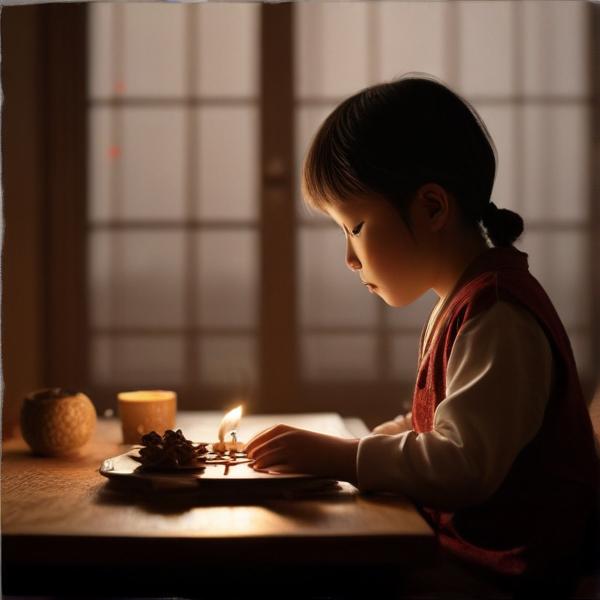基本信息 (Basic Information)
含义与用法 (Meanings & Usage)
中文核心释义 (Core Chinese Meaning): 儿童,少年;未成年人。
英文核心释义 (Core English Meaning): child, youth; minor
象形意义 / 为何这么写 (Pictographic Meaning / Writing Rationale)
文言文释义 (Classical Chinese Meaning)
与现代意义相近,多指未成年的孩子,也可泛指年轻人或童仆。Similar to modern meaning—mostly referring to minors or children, sometimes extending to young people or child servants.
深入学习 (In-depth Study)
字源故事 (Origin Story)
字形演变 (Character Evolution)
常用词语和例句 (Common Words & Examples)
儿童 (Children)
公园里有许多快乐的儿童在玩耍。
Eng: There are many happy children playing in the park.
童年 (Childhood)
我的童年充满了美好的回忆。
Eng: My childhood was full of wonderful memories.
童话 (Fairy tale)
《灰姑娘》是一则著名的童话。
Eng: "Cinderella" is a famous fairy tale.
相关成语 (Related Idioms)
童叟无欺
Meaning: No deception to children or the elderly; honest business
多语言翻译 (核心释义) (Translations (Core Meaning))
- French: enfant, jeune
- German: Kind, Jugendlicher
- Spanish: niño, juventud
- Italian: bambino, gioventù
- Portuguese: criança, jovem
- Russian: ребёнок, юнец
- Arabic: طفل، صبي
- Persian: کودک، نوجوان
- Dutch: kind, jeugd
- Polish: dziecko, młodzik
- Vietnamese: trẻ em, thanh thiếu niên
- Ukrainian: дитина, молодь
视频学习资源 (Video Learning Resources)
通过以下链接在热门视频网站搜索 "童" 的更多讲解:
Search for more explanations of "童" on popular video sites:
- 在 Bilibili.com 搜索 "童 字源 说文解字" (Search on Bilibili)
- 在 YouTube.com 搜索 "tong character origin etymology" (Search on YouTube)
网络参考 (Web References for "童") ()
网络内容摘要 (Web Content Summary):
```html童是一个汉字,最初在甲骨文中是会意字,字形的上部像一把刀(辛或䇂),下部像一只突出眼睛的人,整体表现的是用刑具束缚人的情形,指的是被奴役或束缚的人。 “童” is a Chinese character. In oracle bone script, it is a pictophonetic (idea-compounding) character: the top part looks like a knife (辛 or 䇂), and the bottom resembles a person with prominent eyes, symbolizing a person being restrained by instruments—essentially, a servant or slave.
不过,这种字形在周秦时期已不再使用,而部分六国文字继续保留了这种写法。 However, this form was not carried on in the Zhou and Qin dynasties, though it remained in use in some “Six States” scripts.
- 核心含义:现今“童”常用的意思为“儿童”或“少年”。 Core meaning: Today, “童” usually means “child” or “youth”.
- 相关词汇:如“童年”(childhood)、“童话”(fairy tale)、“童真”(childlike innocence)。 Common words: e.g., “童年” (childhood), “童话” (fairy tale), “童真” (childlike innocence).
- 常见误区:“童”易与“僮”(仆人)和“瞳”(瞳孔)等形近字混淆,需注意区分。 Common confusion: “童” can be confused with look-alike characters like “僮” (servant) or “瞳” (pupil of the eye), so pay attention to differences.
如需详细了解该字字源,可参考专业汉字字源网站。 For detailed etymology, refer to specialized Chinese character origin resources.
```童(汉语文字)_百度百科
童在甲骨文(图1)中是会意字。甲骨文上边是刀形( 辛 或 䇂 ),下部是突出了眼睛的人形,整个字像用刀刺瞎人的眼睛。 基本意思表示一个被刑具束缚着的人的样子,即奴仆。这种形体的"童"字在周秦文字中没有沿袭下来,但六国文字却继承了这一写法。
汉字"童"的起源与演变(源流)-汉字字源网
汉字字源网收录2975个汉字的源流词条,基本涵盖了常用汉字的字源分析,是学习和研究汉字的必备工具。 网站首页 词典首页. 请输入您要查询的汉字: 汉字: 童: 字源: 童.
更多图片 (童 More Images) ()
